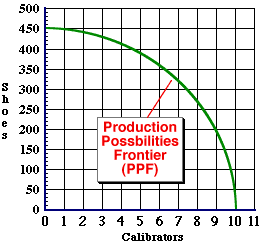
|
|
BALANCE OF TRADE DEFICIT: An imbalance in a nation's balance of trade in which the payments for merchandise imports made by the country exceed payments for merchandise exports received by the country. This is also termed an unfavorable balance of trade. It's considered unfavorable because more goods are imported into the country than are exported out, meaning that domestic production is replaced with foriegn production, which then reduces domestic employment and income. A balance of trade deficit is often the source of a balance of payments deficit.
Visit the GLOSS*arama
|
|


|

|
|
Lesson 4: Production Possibilities | Unit 3: The Curve
|
Page: 12 of 24
|
|
The slope of the production possibilities frontier is opportunity cost. What does this have to do with it's distinct, convex shape? - The reason is the law of increasing opportunity cost.
- With few calibrators produced, opportunity cost is low and curve is flat.
- With many calibrators produced, opportunity cost is high and slope is steep.

|
|
|
|
|

|
|
AGGREGATE DEMAND SHIFTS Changes in the aggregate demand determinants cause the aggregate demand curve to shift. The mechanism is comparable to that for market demand determinants and market demand. There are two alternatives--an increase in aggregate demand and a decrease in aggregate demand. An increase in spending by any of the four sectors--household, business, government, and foreign--shifts the aggregate demand curve to right. A decrease in spending by these four sectors shifts the aggregate demand curve to left.
Complete Entry | Visit the WEB*pedia |



|

|
GREEN LOGIGUIN
[What's This?]
Today, you are likely to spend a great deal of time browsing about a thrift store hoping to buy either semi-gloss photo paper that works with your neighbor's printer or a birthday gift for your father that doesn't look like every other birthday gift for your father. Be on the lookout for the last item on a shelf.
Your Complete Scope
This isn't me! What am I?
|

|
|
Two and a half gallons of oil are needed to produce one automobile tire.
|

|
|
"Progress always involves risk. You can't steal second base and keep your foot on first. " -- Frederick B. Wilcox
|

|
X-M
Net Exports
|

|
|
Tell us what you think about AmosWEB. Like what you see? Have suggestions for improvements? Let us know. Click the User Feedback link.
User Feedback
|


|


